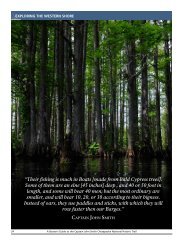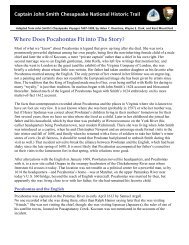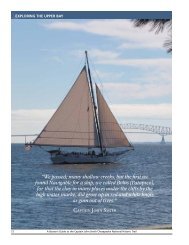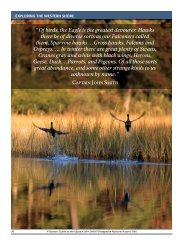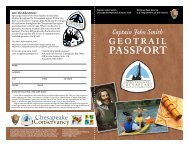Draft Interpretive Plan Join the adventure! - Captain John Smith ...
Draft Interpretive Plan Join the adventure! - Captain John Smith ...
Draft Interpretive Plan Join the adventure! - Captain John Smith ...
Create successful ePaper yourself
Turn your PDF publications into a flip-book with our unique Google optimized e-Paper software.
coal, and rich soil were deposited in several areas of <strong>the</strong> region, especially in <strong>the</strong> vicinity<br />
of <strong>the</strong> present-day Susquehanna River in Pennsylvania.<br />
The mouth of <strong>the</strong> Bay includes a peculiar feature: an impact crater from a meteor that<br />
struck <strong>the</strong>re about 35 million years ago, long before <strong>the</strong> Bay existed. Measuring fifty<br />
miles across, <strong>the</strong> crater includes a depression that probably controlled <strong>the</strong> position of <strong>the</strong><br />
Bay’s mouth and helped concentrate <strong>the</strong> confluence of <strong>the</strong> James, York, Rappahannock,<br />
and Potomac River systems in <strong>the</strong> lower Bay.<br />
Life in <strong>the</strong> Bay<br />
The Chesapeake Bay of 1608 was bordered by hundreds of thousands of acres of<br />
submerged aquatic vegetation, consisting of a wide variety of rooted and flowering<br />
plants. Freshwater streams hosted a dozen or more species, including wild celery,<br />
common waterweed, horned pondweed, and redhead grass. Tidal fresh and brackish<br />
waters contained mostly widgeon grass and eelgrass. This vast complex of streams and<br />
marshland provided havens for juvenile fish, small fish species, blue crabs, and various<br />
invertebrates. Today, <strong>the</strong> marshlands have declined to an estimated seventy-four<br />
thousand acres.<br />
<strong>John</strong> <strong>Smith</strong> encountered shorelines thick with vegetation. In those days, tuckahoe (arrow<br />
arum), pickerelweed, wild rice, and cow lily were found in freshwater areas as well as in<br />
tidal fresh and brackish waters. Saltmarsh cordgrass dominated <strong>the</strong> saltier marshes.<br />
Waterfowl and shore birds fed on seed plants such as black needlerush and three-square<br />
sedges.<br />
<strong>Smith</strong> described <strong>the</strong> great variety of fish he found in <strong>the</strong> Bay and its tributaries:<br />
Of fish we were best acquainted with Sturgeon, Grampus<br />
[pilot whales], Porpus, Seales [river otters], [and]<br />
Stingraies, whose tailes are very dangerous. Bretts,<br />
Mullets, white Salmonds, Trowts, Soles, Plaice, Herrings,<br />
Conyfish, Rockfish [striped bass], Eeles, Lampreys,<br />
Catfish, Shades [shad], Pearch of three sorts, Crabs,<br />
Shrimps, Crevises, Oysters, Cocles [whelks], and Muscles.<br />
Later writers who saw <strong>the</strong> Bay in its seventeenth-century splendor described <strong>the</strong> massive<br />
spawning runs of anadromous fishes, including striped bass, white perch, and sturgeon.<br />
Menhaden, not truly anadromous, was also seen in such quantities that it was likely <strong>the</strong><br />
fish that <strong>Smith</strong> and his crew attempted to catch with a frying pan on <strong>the</strong> Potomac River in<br />
June 1608. Resident predator fish—aside from those like <strong>the</strong> striped bass that feed<br />
opportunistically on spawning fish—included <strong>the</strong> longnose gar, bowfin, and chain<br />
pickerel. Eels, which were spawned in <strong>the</strong> Sargasso Sea, made <strong>the</strong>ir way to <strong>the</strong> Bay and<br />
o<strong>the</strong>r coastal waters to swim upstream and live most of <strong>the</strong>ir adulthood before returning<br />
to <strong>the</strong> Sea to spawn and die. Temporary visiting species frequently included vast<br />
numbers of bluefish and Spanish mackerel, as well as kingfish, black drum, and red<br />
drum. Sandbar sharks, as well as various skates and rays, were seen in <strong>the</strong> lower Bay, as<br />
<strong>Smith</strong> knew from painful personal experience. Marine mammals included dolphins, pilot<br />
121



